What Our Favorite Dogs Teach Us About Working at CSD
For the past few months, the Center for Shelter Dogs has been under a period of transition. While our work with shelters and the community continues on, we’ve also had some opportunity to reflect back on what we’ve accomplished so far – our work, our achievements, and most especially the many, many dogs whose lives we have touched. So we thought it would be a great opportunity for us to talk about a few of these dogs, and why we do what we do, not just for our own shelter but for many all around the world.
Lauren Gilfeather
My favorite dog from CSD is, of course, my own little boy, Ty. A dachshund-corgi mix, he came to the shelter in late September 2012 as an owner surrender at age two. It seemed like he’d had a rough start, and exhibited many problem behaviors CSD sees: food aggression, resistance to handling, protective aggression, fear of people, reactivity, and limited housetraining. He was listed as a special adoption. He came up to the CSD offices from the shelter to foster with Laney Nee, and the moment I laid eyes on him, I knew he was my dog. He’d been incredibly fearful, but when I walked by Laney’s office, he trotted right up to the dog gate with tail wagging, asking me to pet him. I was smitten. I would never have been able to learn to effectively manage Ty’s problem behaviors without the help of CSD staff and the years of research that have been done. Dr. Sheila D’Arpino, Laney Nee, and Kim Melanson were all integral in helping Ty and I adjust to life together. His adoption was finalized in November 2012 — he’s been home with me for 18 months, and he’s an entirely different dog. He’s housetrained, no longer growls over his food, allows anyone and everyone to handle him (even the vet techs!), and is no longer as fearful. He still is reactive to other dogs, but with training from Kim using the techniques outlined in the reactivity handout, we successfully manage that behavior. He is a joyful dog who is thriving in our family, and I could not be more grateful to have had CSD with me every step of the way to make this match possible.
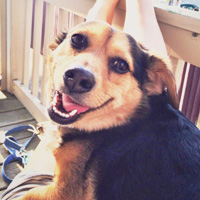
Jadi Macasaquit
With my position as the admin assistant for the Center for Shelter Dogs, it wasn’t really part of my work to be interacting with dogs on a daily basis. But when I first started working for CSD, it did not take me long to realize how different this place is from every other office I have ever worked in. Case in point, our location at ARL Boston makes our office ideal for our Office Foster program, when we take dogs from the shelter (often those not doing so well in the kennel environment) and spend time with them in our offices during the day. And that was how I had the pleasure of meeting Morgan. An adorable, stubby-legged, little pitbull thingy, Morgan defied identification by breed, expectations, and even simple descriptions! She was a sweetheart, very eager to explore and extremely friendly. In short (if you’ll pardon the pun), she was a mascot for CSD’s tagline, Because every dog is different. For me, meeting Morgan was like a warm welcome into the sheltering community, and a visual reminder that every day, I’m not just coming into work, shuffling papers, but also working to help real people help real dogs live better lives.
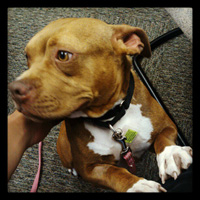
Dr. Shiela D’Arpino
My favorite dog was Putney. She was a 14 pound, 11 year old female spayed Rat Terrier, who I met when I first started working at ARL, who I fostered and eventually adopted. She was a feisty old girl with a huge personality. Putney had been owned by a woman who had many personal challenges, and couldn’t adequately care for her dog even though she loved her dearly. When Putney was happy, she greeted you with an exuberant greeting, “awoooooooooo!!” When she wasn’t happy, you knew that too. She had very strong feelings about things. For example, if you tried to touch her when she didn’t want to be touched, she let you know with a growl or a snap!
Putney taught me about love, kindness, and community, in several ways. She didn’t fit most people’s vision of an ideal dog. For just one example, Putney wouldn’t let us hug her! But she enriched our lives and made us happy. If we respected Putney’s needs and desires, she respected and loved us. If we had attempted to force Putney to fit a mold of how a dog should behave, she would have been miserable and we would have missed out on so many aspects of her personality that were endearing. Every dog is different, and Putney taught me to celebrate seemingly insurmountable differences.
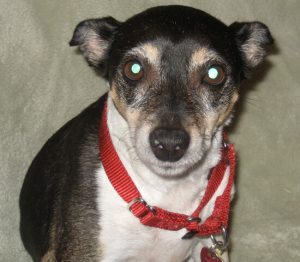
One of my most memorable Putney stories happened in the midst of a severe snowstorm a few years ago, before she came to live with is. She had been in the custody of her previous owner, who at the time was experiencing some difficult times and was living in temporary housing. I wanted to check in on the owner, and especially Putney, to make sure that they were both ok and not snowbound. When I went to see them, they weren’t there. That evening, two of my wonderful coworkers, Lt. Alan Borgal and Laney Nee, went out in dark, inclement weather in a bad neighborhood to track down Putney and Kim for me. It was not simply out of fondness of Putney, or even Kim, but Laney and Alan went out because there was a dog and a person in need. The Animal Rescue League of Boston is full of people like this; people who step in and make a difference when many others wouldn’t. Kindness uplifts the world.
Kim Melanson
As one of CSD’s Behavior Counselors, and a licensed dog trainer myself, I’ve worked with quite a lot of different dogs, and it’s difficult to choose just one. But let me tell you about one in particular. Red came in as a very fearful and shy dog. In his first few days, he had a hard time adjusting to the city, especially with all the noise and the people approaching him. When he heard a noise, he would back away and often dart to the end of his leash. He even had his tail tucked most of the time. We decided to work with Red for a few weeks and see if he warmed up and became more comfortable. It was slow going at first, all about letting Red adjust and feel safe, and then letting him progress on his own. Within a month or so of working with him, using positive reinforcement, and with the kindness of everyone at the ARL, Red started to blossom and come out of his shell. He still had his moments of fear with odd noises but had started to get used to the basic city noises and would walk with his tail up, wagging at people he knew and was friendly with. Unfortunately, perhaps because he was labeled as a “pit bull mix”, Red ended up spending a longer time in the shelter, waiting for adoption. As a result, his behavior began to deteriorate again, and the anxiety he experienced earlier started coming back. So I decided to take him home to foster for three weeks to see how he did in home setting. While I do live in the city, it’s a much quieter neighborhood, and our house has a backyard. In the short time that he was with us, Red really seemed to have flourished. He played with my younger dog, learned to leave the testy older dog alone, and also played fetch with the older kids of the neighborhood. He greeted all people who he knew with wags and wiggles.
Sadly, I already had two other dogs (and a landlord!) so adopting him was not an option. But we decided that, since shelter life was not helping Red either, we needed another option for him. When my foster time was up we transferred him to a trainer and rescue in New Hampshire, who would evaluate him, work with him more and find him the right home and they did! He was adopted a month or so later by a family who had a 16 year old daughter who he fell in love with. He slept in her bed and had a big back yard to run in. So he finally got the home he deserved.
Red was my first tougher dog with a behavior issue as a dog trainer and he taught me so much. First and foremost, he taught me to be patient and to let a dog have its own time and space, to learn and change. He also taught me that not every dog can be adopted out to the community that your shelter or rescue might be in, but if we reach out and explore relationships with the sheltering community, we might be able to find other options for these dogs. Last of all, he taught me to treat and evaluate every dog as an individual with a distinct personality, different needs, and different futures. Thank you Red!
Anastasia Shabelansky
My favorite dog was Bailey, an orange cocker spaniel mix and my first foster dog. I fell in love with this dog, especially because she was able to change the way my husband thought of dogs in general! My husband grew up without animals in his house and the only interaction he had with dogs was experiencing his neighbor dog barking at him every day, so did not have a lot of great experiences with them. So I wanted to introduce him to Bailey. The building where we are living had a no-animal policy; so unfortunately, I could not bring Bailey home with me. But I decided to take her for walks during the weekends. After all, even if we do all that we can to make it comfortable for our dogs, all of them would appreciate being out of the shelter, at least for a while! Once time, I asked my husband to join me. He refused in the beginning since he is not a big fan of dogs but I was very persistent and dragged him to the park with me. We picked up Bailey from the shelter and went to the park for an hour. The little doggie followed my every single step and movement. She jumped on the bench when I decided to rest. She was on my lap in a little café, when we stopped to get a cup of tea. She ran towards me happily when I was calling her over. I guess she reminded my husband of a little child, who follows her mommy’s every single step and look at her with admiring eyes. My husband loves children, but he did not realize until then that a little doggie could be capable of just as much affection and love. We brought Bailey back to the shelter, and the moment shelter staff took her leash she started to cry and pull towards me and my husband. He definitely did not expect that. On our way home he was very upset and kept asking me how it was possible to spend only a brief couple of hours with a dog, and to have her already so attached. “Well,” I answered, “It’s very easy to become a dog’s friend. You play with her, pet her, smile to her and she will trust you and be your best friend. Unlike people, dogs don’t remember betrayals, don’t judge or get offended. It is easy to get their forgiveness, and they don’t care about your intelligence, good manners or sense of humor. You become their friend just by being there for them.” My husband looked at me and nodded, silently. When next week I decided to take Bailey for a walk he asked to go with me.
Carol Ahearn
I couldn’t decide on my own favorite, because we’ve worked with so many wonderful dogs over the years. But here are three of the ones that come to mind. All three of them had spent an extended stay at the Dedham Shelter, where I am based, but thanks to the guidance of CSD, and of course the persistent efforts of our fabulous staff and volunteers in Dedham, all three of them were able to find their homes.
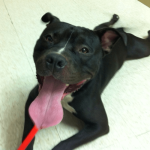

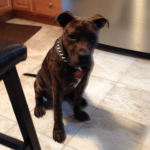
Donna Iovanni
Working for the Center for Shelter Dogs, and at the Animal Rescue League of Boston, I have been fortunate to see, time and time again, the difference we can make for the animals in our care. Whether it’s helping them medically, helping them feel less stressed, giving them good food, good love, finding them the right home, teaching them some basic manners, modifying a not so desirable behavior, or even simply a bath and a good grooming! What has stood out to me the most about this is that it takes the whole team to make it work. And I am blessed to work with a team of dedicated, compassionate, and knowledgeable people here at the Animal Rescue League of Boston. My favorite canine story is about a black lab named Beau, because it illustrates this process so perfectly. Beau is a beautiful 70 pound, 8 year old Black Lab that found his way from a North Carolina rescue through a local Animal Control facility to the Animal Rescue League of Boston. When he arrived, it was clear that he had some serious vision problems. Our shelter vet diagnosed him with bilateral cataracts and secondary glaucoma. He was totally blind, and recently so. Beau was facing the stress of not only being a dog in a shelter, but being a dog trying to adjust to being blind in a shelter. And it showed. He was barking frantically, whining, or panting most of the time, crashing into things at full speed when he walked, and if he heard or smelled another dog he barked, lunged, and snapped wildly in all directions. The poor guy was overwhelmed.
The shelter team went to work. His eye surgery was performed to relieve the pain and pressure in his eyes. Shelter staff and volunteers are making sure he is comfortable in his kennel, talked to, soothed, enriched with yummy Kongs and treats. Since doggie playgroup is too stressful for him (most likely because he can no longer read other dog’s signals) he is taken for numerous walks daily and given one-on-one attention. He is brought up to a “quiet space” office periodically so that he can relax away from the smells and noises of the kennel. A training plan was written for him that uses cue sounds and touch to help him move around safely and confidently. All of the staff and volunteers are working on this plan with him daily. And all of this is making a difference for him. I looked out the window yesterday and saw a volunteer walking him – one of the most beautiful sights I’ve ever seen – Beau walking down the street with a smile on his face – and not bumping into a single thing. The resilience and joy of dogs!
Beau has not been adopted yet. But I know that when he is, his new owner(s) will be counseled by a staff member who is caring and competent and completely dedicated to his future well-being. And my heart is full.
Dr. Gary Patronek
One of the dogs I remember most was Sydney. I helped carry him out of a life-threatening cruelty situation in the early years of the CSD. Although he was a big fellow, I remember a very scared dog who took a while to recover and come out of his shell. He spent a lot of time upstairs with all of us since he wasn’t doing very well in the kennel, and legal proceedings were dragging on. Despite being a victim of a crime, the law required he be treated as evidence instead, so he had to say with us when all he wanted was a home and someone to rub his belly on a regular basis. I remember how happy we all were when a nice young couple adopted him and sent us pictures of him laying with them on the couch. We were all so sad when, due to a divorce, he was later returned to the shelter. It seemed his sadness would never go away and that didn’t add to his prospects for adoption. To try to relieve his depression, we finally sent him to a good friend of the League in New Hampshire to continue his foster care in a more relaxed rural setting. It took a while, but one of the most rewarding moments was hearing that he was again adopted, living with a great couple with cats and a house on a lake. If a dog could smile, I can imagine him grinning from one big ear to the other. Persistence, learning about that dog as an individual, and trying something different paid off. He’s a different dog now. What Sydney reinforced in my mind was that although shelters and all of their good intentions can be life saving, they may not be life sustaining environments, and you may never really know who a dog really is based upon their behavior in an institutional setting. Dogs, like people, needs homes and someone to love them to see who they really are and can become.
Dr. Amy Marder
What I have learned from over the almost 20 years that I have been evaluating and working with shelter dogs is that every dog is different and special in their own way: The fearful little dogs, the jumpy mouthy large dogs and the food-aggressive dogs. I have also learned that in spite of all of the enrichment programs that we provide for our dogs, life in the shelter is still difficult for most dogs. Although some adjust better than others, it is still a tough place to live. The most important thing that shelter dogs are missing is a human partner that they can depend on. And we now know how the presence of a close human can influence canine behavior. An example can be found in food-related aggression: We have learned through our food aggression research [LINK] that a dog’s behavior can drastically change after he or she gets settled in a home with reliable caretakers. Almost 50% of the dogs that showed food aggression on the behavior evaluation in the shelter did not show food aggression after adoption. The stress associated with living in the shelter and the presence of other potentially competing dogs, may lead to the appearance of food-related aggression on the behavior evaluation.
So the best thing that we can do for abandoned dogs is to find homes with accepting and compatible humans. Our Match-Up II shelter dogs rehoming program allows us to get to know each dog as best as we can in the shelter environment to put us on the way to finding the best homes. And our Special Adoption program allows us to easily counsel adopters on the management of behavioral issues. All of our programs teach us and users that every dog is an individual with their own personality and needs. And as a result we have learned that EVERY dog is special!